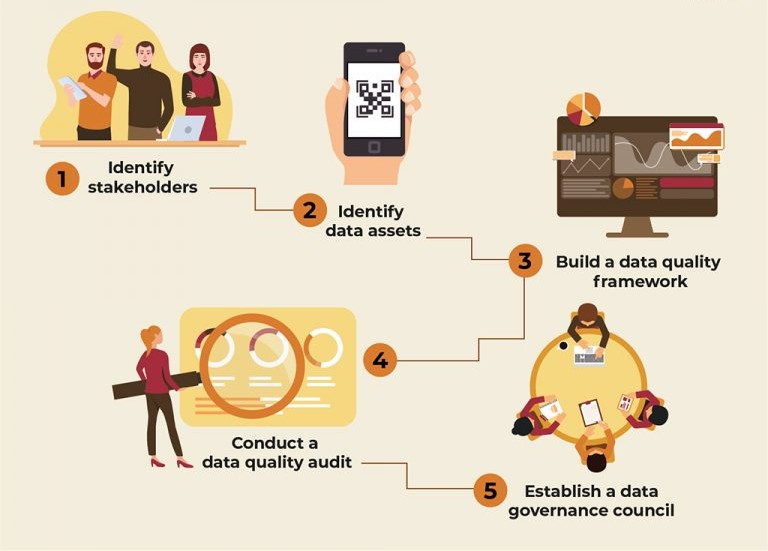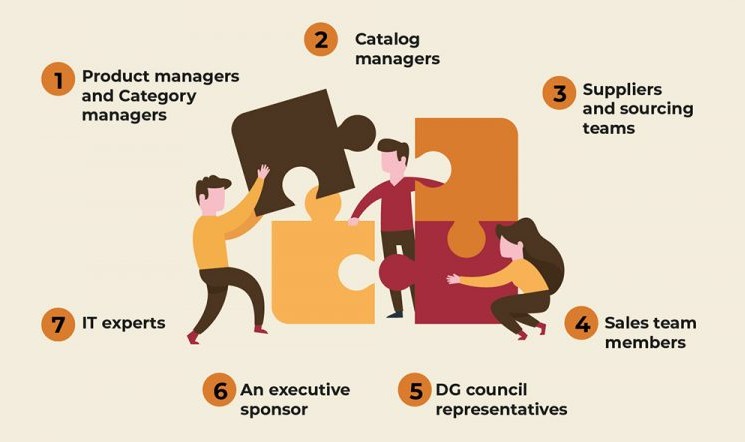
Bringing together the right people to form a PIM team is the first crucial step for a successful PIM implementation. In this blog post, we discuss the key stakeholders you consider include in your PIM team.

The best approach to managing ‘data’ is to bring together the right people. Forming your PIM team—identifying stakeholders and gaining their buy-in is a crucial step in the success of a PIM program.
Building a product takes a village. So does building a PIM.
Steps for PIM initiative
In the first part of this series on Product Information Management (PIM), we argued for the need of a PIM in any product company. We discussed how having a strategic PIM program can expedite GTM, boost sales, reduce product returns and improve customer satisfaction.
In continuation, we are discussing how you can build your PIM. Like most data governance initiatives, building a PIM in your company involves people, data, processes and systems. A strategic PIM initiative follows the following steps:
- Identify stakeholders
- Identify data assets
- Build a data quality framework
- Conduct a data quality audit
- Establish a data governance council
In this post, we’ll elaborate on step one: Identifying stakeholders and bringing together a core working group to plan and drive the implementation of your PIM.

Whom do you invite for a PIM strategy meeting?
Building, marketing and selling a product involves multiple stakeholders across departments, each of them responsible for and uniquely skilled in a specific part of the endeavor. A successful PIM deployment needs to carefully identify these stakeholders and bring them to the table for meaningful collaboration. One too many stakeholders may just spoil the broth. One too few might make it incomplete. Thus, bringing together the perfect group of people is the first and most important step to building your PIM.
Based on our experience, we’ve observed that the following people together make the best PIM working group.
1. Product managers and category managers
Product/category managers, as custodians of the product, know the ins and outs of the product — from specifications of the product itself, all the way up to customer feedback and preferences. They have an end-to-end view of the product journey, making them an important stakeholder in the PIM initiative.
2. Catalog managers
Catalog managers interact with product information every day, gaining significant tacit knowledge about the landscape of offerings in any organization. In fact, in most e-commerce companies, a catalog manager is responsible for building sales offers such as summer catalog or Thanksgiving catalog, making them an agile bridge between product and sales.
They also tend to know intangibles like nomenclature, data formats and the like. Having them on the PIM core working group is a great boost to the accuracy, relevance and completeness of data.
3. Suppliers and sourcing teams
Your PIM is only as good as the data in it, and a lot of this data comes from suppliers. For instance, the quality and grade of the glass that goes into making a mobile phone is an important input for marketing the final product. This information needs to come from the supplier of said glass. By inviting key suppliers and the sourcing team to your PIM strategy meetings, you can get their inputs about the data that comes from outside your system, which is also crucial.
Moreover, suppliers tend to provide data in different formats, and the catalog team restructures it to fit requirements. Having suppliers and sourcing team on the PIM working group makes you cognizant of these differences and accommodate them.
4. Sales folks
Salespeople often have the pulse of the customer. They will know what questions customers are asking about any product on offer. In an e-commerce scenario, for instance, a sales manager might also know what terms are being searched for and what is contributing to its discoverability. This means they can tell what data needs to be on the Product Information System to begin with.
5. A data governance council representative
A PIM works best when it is in alignment with your larger data governance policies. A DG council representative can help ensure the continued good health and adoption of PIM after it is rolled out. Invite a member from the governance committee to your strategy meeting, if you have a DG program in place.
If you don’t have a DG program in your organization, use your PIM initiative as the first step to build one.
6. An executive sponsor
Every successful project in an organization benefits from the focused support of a leader — a PIM implementation, more so, because it requires collaboration between cross-functional teams. An executive sponsor can evangelize the change, clear obstacles in the path, and impress upon skeptics.
7. An IT expert
While the IT team is not directly invested in the business outcomes of a PIM, it does the heavy lifting when it comes to setting it up. Make sure you involve an IT specialist to understand the ramifications a PIM can have for existing infrastructure and operations. A little down the line, this person can also play an important role in selecting a PIM vendor.
Besides these stakeholders, it may help to invite representatives from other teams such as customer service and legal, depending on your product landscape, industry, geography, etc.
And there you have it, your fellowship of the PIM! The next step is to get your data house in order. We’ll bring some tricks for you in the next blog post.

Do talk to us if you’d like to understand how to implement a PIM in your organization.


